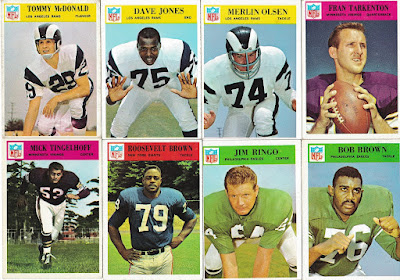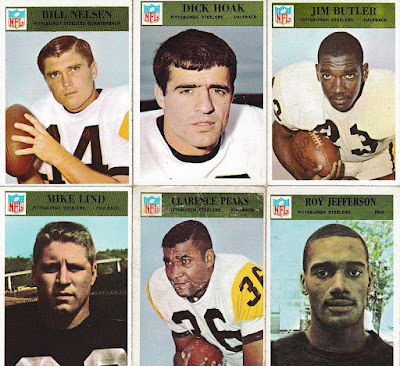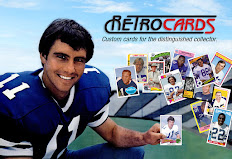Sunday, May 5, 2024
Philadelphia Eagles - Custom Extension Set
Saturday, April 27, 2024
Dallas Cowboys - Custom Extension Set
Saturday, April 20, 2024
Hall of Famers
Saturday, April 13, 2024
Checklists & Miscellaneous Cards
Each of the Philly Gum sets (from 1964 to 1967) had 2 series, and a total of 198 cards. As expansion teams were added in '66 and '67, they just decreased the number of cards per team.
I got both of these checklists a few months ago. They are as-is, and don't indicate which cards I have.
The back of each team photo card included a referee signal. Leftover signals were grouped on this Signals card (the same as in the 1967 set). This signals card is in the worst condition of ALL my football cards. I don't think I will replace it, as the money is better-spent on a player's card.
Next: Hall of Fame players in the 1966 set
Saturday, April 6, 2024
Green Bay Packers
Saturday, March 30, 2024
Dallas Cowboys
Saturday, March 23, 2024
Cleveland Browns
Sunday, March 17, 2024
Chicago Bears
Saturday, March 9, 2024
Baltimore Colts
Sunday, March 3, 2024
Washington Redskins
The Redskins were founded in 1932 as the Boston Braves, and moved to Washington in 1937. Over their first 14 seasons, they won their division 6 times, winning the NFL championship twice.
For the 25 seasons from 1946-70 they never made the post-season, winning as many as 8 games only once (1955). In Vince Lombardi’s lone season as head coach (1969) the team posted a 7-5-2 record, their first winning season since 1955.
Head coach George Allen arrived in 1971, and the team made the playoffs 5 times in Allen’s 7 seasons, losing Super Bowl VII after the 1972 season. In 1966 they posted a 7-7 record, a one game improvement over 1965’s 6-8 record.
The Dick Shiner and Sam Huff cards were made by RetroCards and are not part of the original set. Of the remaining 11 cards, I only had Vince Promuto and Jim Steffen’s cards since the 1960s, and they are in fair-to-poor condition. I got all the rest in the past 3 months.
Sonny Jurgensen was the Eagles’ 4th-round pick in 1957, who the Redskins acquired from the Eagles after the 1963 season for Norm Snead. He was their starting QB from 1964-70, with Bill Kilmer taking over at the start of the Allen regime. Sonny was a 5-time Pro Bowler, and led the NFL in passing yards 5 times. He was inducted into the Hall of Fame in 1983.
Saturday, February 24, 2024
San Francisco 49ers
Friday, February 23, 2024
Wow, Somebody Likes the Rams!
Since I started this blog a few months ago, I have posted 8 of the 15 NFL teams. Here are the views as of today:
Saturday, February 17, 2024
St. Louis Cardinals
 Charley Johnson was the Cardinals’ 10th-round pick in 1960. He was their starting QB from 1962-66, and again in 1969. (Johnson was in the Army during 1967-68, but received weekend passes to attend the games, backing up Jim Hart.) Johnson was the Oilers’ starting QB in ’70 and ’71, then after backing up rookie Dan Pastorini in 1971, he played for the Broncos from 1972-75, starting most games until his final season.
Charley Johnson was the Cardinals’ 10th-round pick in 1960. He was their starting QB from 1962-66, and again in 1969. (Johnson was in the Army during 1967-68, but received weekend passes to attend the games, backing up Jim Hart.) Johnson was the Oilers’ starting QB in ’70 and ’71, then after backing up rookie Dan Pastorini in 1971, he played for the Broncos from 1972-75, starting most games until his final season. Terry Nofsinger was drafted by the Steelers in 1961, and played 9 games (no starts) for them over 4 seasons. He played for the Cardinals from 1965-66, and started 5 games in 1966. He was also a backup for the Falcons in 1967. This card was not part of the original set, but was made by RetroCards.
*Bill Triplett – The brother of Giants’ fullback Mel Triplett, Bill was drafted by the Gints in 1962, but played his first 4 seasons for the Cardinals. The Cards’ strong safety during his rookie year, he was their starting halfback in ’63 and ’65 (missing the 1964 season). After riding the Cardinals’ bench in 1966, he spent a year with the Giants, then played for the Lions from 1968-72. He was Detroit’s starting halfback in ’68 and ’69.
*Willis Crenshaw was drafted by the Cardinals in 1963. After a year on the sidelines, he was their fullback from 1964-69, starting most games in ’65 and ’68. He finished up with the Broncos in 1970, starting 12 games at fullback.
Bobby Joe Conrad was drafted by the Giants in 1958, but played his first 11 seasons (1958-68) with the Cardinals. A cornerback during his rookie year, he moved to flanker the next season and started all but 9 games there from 1959-68. He was also a kicker during his first 3 seasons. Conrad led the NFL with 73 receptions in 1963 and was named first-team All-Pro. He spent his final season (1969) with the Cowboys.
*Sonny Randle – An undrafted free agent, Randle played for the Cardinals from 1959-66 and was their starting split end from 1960 to 1966, but missed 7 games in 1964. He made the Pro Bowl 4 times and was named first-team All-Pro in 1960. He also played for the 49ers and Cowboys from 1967-68.
Sunday, February 11, 2024
Pittsburgh Steelers
Sunday, February 4, 2024
Philadelphia Eagles
Sunday, January 28, 2024
New York Giants
Sunday, January 21, 2024
Minnesota Vikings

































































